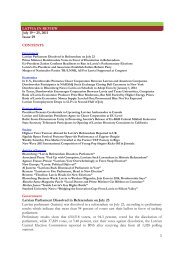Latvian Folk Dress - Latvijas Institūts
Latvian Folk Dress - Latvijas Institūts
Latvian Folk Dress - Latvijas Institūts
You also want an ePaper? Increase the reach of your titles
YUMPU automatically turns print PDFs into web optimized ePapers that Google loves.
14th-17th century<br />
German crusaders arrived in the first half of the 13th century and the<br />
<strong>Latvian</strong> territories were gradually conquered. Germans remained the<br />
ruling class in Latvia until the early 20th century, thus influencing the<br />
dress of local people. Under German rule the living conditions of local<br />
people worsened and the tradition of decorating clothing with bronze<br />
disappeared. The use of bronze jewellery also diminished significantly.<br />
This led to the consequence that very little clothing was preserved in<br />
gravesites. Therefore our knowledge of people’s clothing in the 14th-<br />
17th centuries is limited.<br />
However, written and drawn records gradually started to appear,<br />
reflecting local dress in the 17th and 18th centuries. From these drawings<br />
we can see that the traditions of ancient dress survived to a great extent,<br />
as many garments are very similar. Linen tunics remained of the same<br />
cut, as did woollen coats, however a front opening fastened with hooks<br />
became more prevalent, especially in men’s clothing. Women’s skirts,<br />
in addition to the older style of just a rectangular piece of fabric, were<br />
now also fixed to the sash in small folds. Most of the garments were still<br />
monochromatic, and stripes were rare. Knitwear began to appear in the<br />
15th century, evidenced by the first knitted woman’s cap. Naalbinded<br />
items gradually disappeared and the tradition of knitted mittens, gloves<br />
and socks developed to perfection, reflecting<br />
regional differences in ornament and taste in colour.<br />
Starting from the 16th century, imported European broadcloth<br />
reached <strong>Latvian</strong> peasants, and clothes made from it were considered<br />
to be a sign of wealth. However there is much less jewellery from this<br />
period, and we can observe that its old forms had mostly disappeared.<br />
The only exception is the girls’ crowns that continued to be made either<br />
of bronze plate or red fabric that was ornamented with glass beads of<br />
various colours. These crowns had coloured pendants fastened at the<br />
back of them, but slowly these pendants disappeared and were worn<br />
in only a few parishes in the 19th century. Rings and beads made by<br />
guild craftsmen in feudal towns are frequently observed, as are various<br />
pendants (small animal figurines, coins, animal teeth); unfortunately the<br />
significance of these pendants is unclear. The older types of fibulas that<br />
were usually in the shape of a horseshoe were superseded by circular<br />
or heart-shaped brooches. One of the most popular items of women’s<br />
jewellery was a string of cowrie shell beads. During this period, the<br />
most creative aspect and largest regional variations can be observed in<br />
women’s head coverings, while other parts of clothing remained fairly<br />
uniform.<br />
8 9






